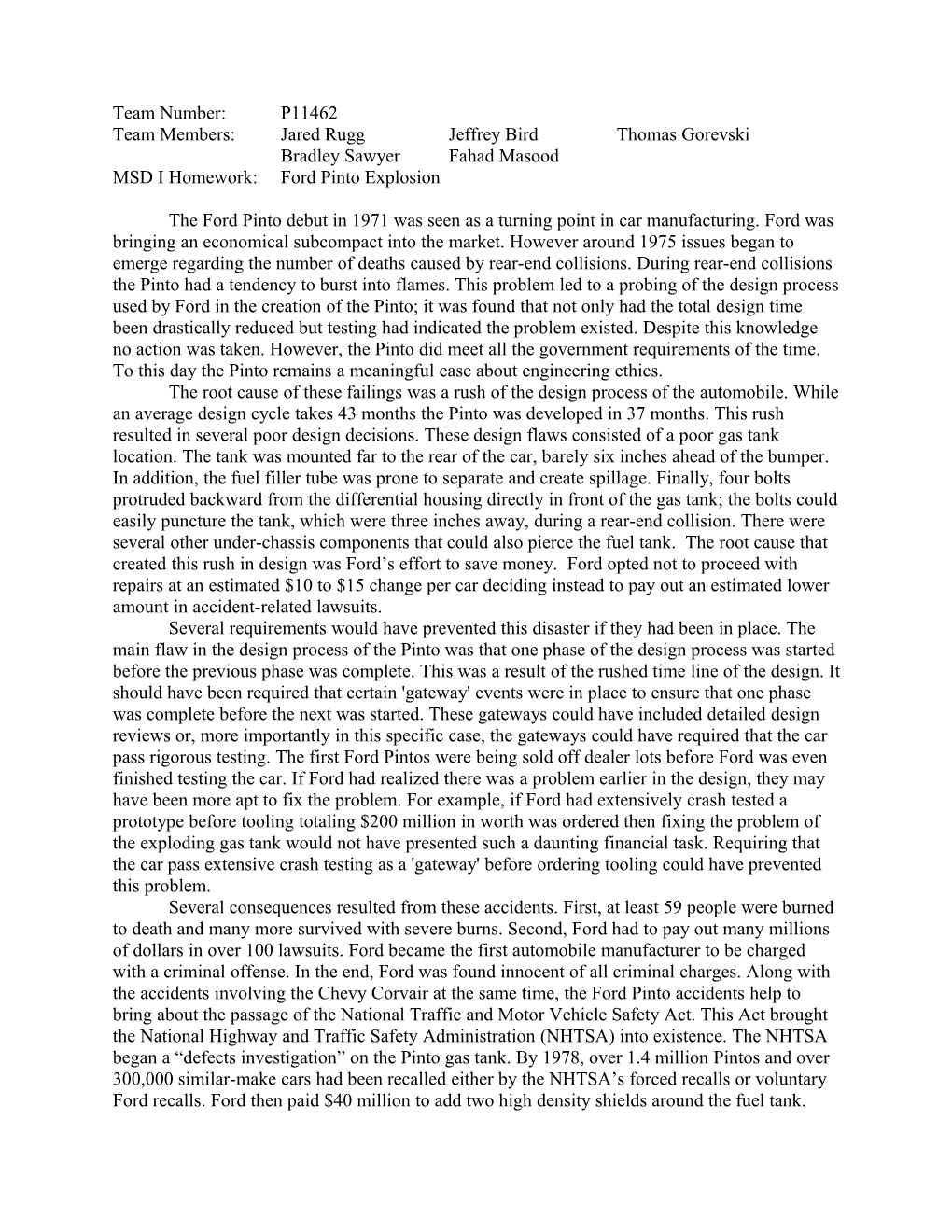Team Number:P11462
Team Members:Jared RuggJeffrey BirdThomas Gorevski
Bradley SawyerFahad Masood
MSD I Homework:Ford Pinto Explosion
The Ford Pinto debut in 1971 was seen as a turning point in car manufacturing. Ford was bringing an economical subcompact into the market. However around 1975 issues began to emerge regarding the number of deaths caused by rear-end collisions. During rear-end collisions the Pinto had a tendency to burst into flames. This problem led to a probing of the design process used by Ford in the creation of the Pinto; it was found that not only had the total design time been drastically reduced but testing had indicated the problem existed. Despite this knowledge no action was taken. However, the Pinto did meet all the government requirements of the time. To this day the Pinto remains a meaningful case about engineering ethics.
The root cause of these failings was a rush of the design process of the automobile. While an average design cycle takes 43 months the Pinto was developed in 37 months. This rush resulted in several poor design decisions. These design flaws consisted of a poor gas tank location. The tank was mounted far to the rear of the car, barely six inches ahead of the bumper. In addition, the fuel filler tube was prone to separate and create spillage. Finally, four bolts protruded backward from the differential housing directly in front of the gas tank; the bolts could easily puncture the tank, which were three inches away, during a rear-end collision. There were several other under-chassis components that could also pierce the fuel tank. The root cause that created this rush in design was Ford’s effort to save money. Ford opted not to proceed with repairs at an estimated $10 to $15 change per cardecidinginstead to pay out an estimated lower amount in accident-related lawsuits.
Several requirementswould have prevented this disaster if they had been in place. The main flaw in the design process of the Pinto was that one phase of the design process was started before the previous phase was complete. This was a result of the rushed time line of the design. It should have been required that certain 'gateway' events were in place to ensure that one phase was complete before the next was started. These gateways could have included detailed design reviews or, more importantly in this specific case, the gateways could have required that the car pass rigorous testing. The first Ford Pintos were being sold off dealer lots before Ford was even finished testing the car. If Ford had realized there was a problem earlier in the design, they may have been more apt to fix the problem. For example, if Ford had extensively crash tested a prototype before tooling totaling $200 million in worth was ordered then fixing the problem of the exploding gas tank would not have presented such a daunting financial task. Requiring that the car pass extensive crash testing as a 'gateway' before ordering tooling could have prevented this problem.
Several consequences resulted from these accidents. First, at least 59 people were burned to death and many more survived with severe burns. Second, Ford had to pay out many millions of dollars in over 100 lawsuits. Ford became the first automobile manufacturer to be charged with a criminal offense. In the end, Ford was found innocent of all criminal charges. Along with the accidents involving the Chevy Corvair at the same time, the Ford Pinto accidents help to bring about the passage of the National Traffic and Motor Vehicle Safety Act. This Act brought the National Highway and Traffic Safety Administration (NHTSA) into existence. The NHTSA began a “defects investigation” on the Pinto gas tank. By 1978,over 1.4 million Pintos and over 300,000 similar-make cars had been recalled either by the NHTSA’s forced recalls or voluntary Ford recalls. Ford then paid $40 million to add two high density shields around the fuel tank.
